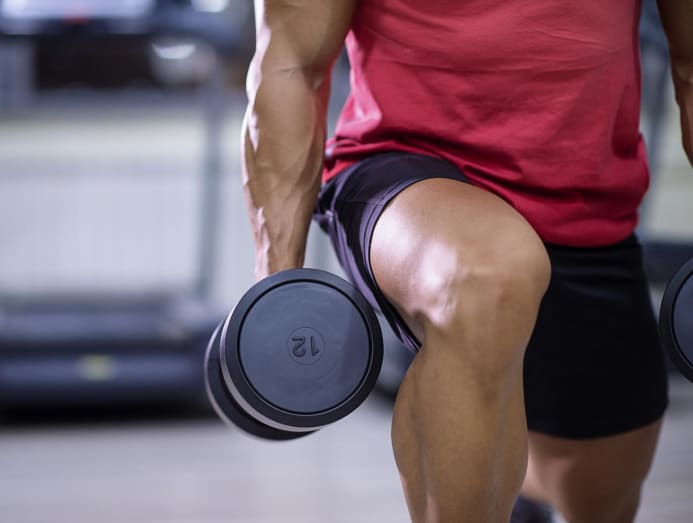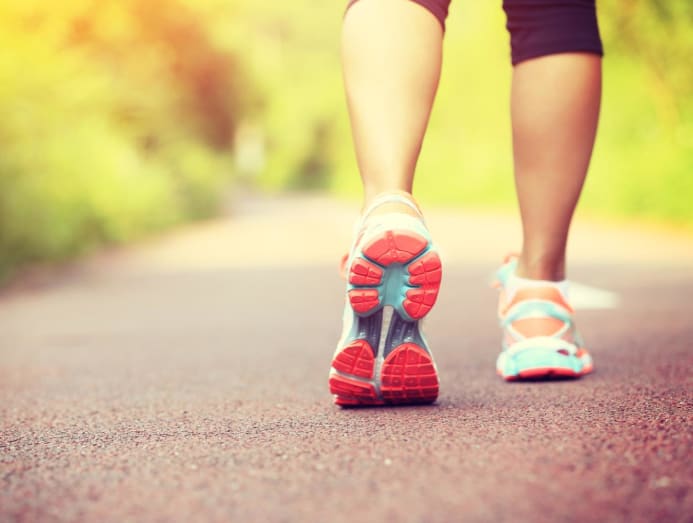How this unusual exercise while sitting down can help lower your blood sugar and fat levels
It’s called a soleus push-up and it involves activating that muscle in your calf by “tiptoeing” while sitting down. CNA Lifestyle asks experts to find out just how effective this can be.

(Photo: iStock)
Here’s an exercise that many sedentary individuals and office workers could get behind: Soleus push-ups. No, it isn’t an extreme or even a levelled-up version of the push-up; it doesn’t even involve the same muscles.
Instead, much like how some of us like to jerk our legs up and down when seated, this exercise involves starting with your foot flat on the floor, then raising your heel off the ground to its highest points and letting it fall back down. Think of it as doing a tiptoeing exercise while sitting down.
The key takeaway is that the action, when done correctly, activates the soleus muscle and boosts oxidative metabolism during which blood sugar is utilised at “high levels for hours, not just minutes”, said its creator Marc Hamilton, a professor of Health and Human Performance at the University of Houston, USA.
Not only that, keeping the soleus muscle metabolism humming is also effective at doubling the normal rate of fat burning between meals, he said.
In his study published in iScience in 2022, test subjects were given a glucose drink each before performing soleus push-ups in a controlled setting for 270 minutes spread out over the day. That’s 4.5 hours of leg shaking if you’re counting. The results: There was a 52 per cent improvement in blood glucose fluctuations and 60 per cent less insulin requirement that lasted over three hours.
According to Prof Hamilton, the 600 muscles in your body usually contribute only about 15 per cent of your total body’s oxidative metabolism in the three hours after consuming carbohydrate.
“Despite the fact that the soleus is only 1 per cent the body weight, it is capable of raising its metabolic rate during soleus push-up contractions to easily double, even sometimes triple, the whole-body carbohydrate oxidation.”
Elevated levels of blood sugar and fats have always been associated with metabolic syndrome, which is a collection of health issues occurring together, including high blood pressure, Type 2 diabetes, stroke and heart disease.
What this could mean is that the very leg-shaking action that many of us regard as a bad habit could well help you lower your blood sugar level – and reduce your risk of metabolic diseases such as heart disease, stroke and Type 2 diabetes.
So why is this muscle so special? Are there other muscles in our bodies that could also deliver the same benefits? And should you give this push-up a shot?

WHAT IS THE SOLEUS MUSCLE AND HOW DOES IT WORK?
The soleus muscle is part of the calf muscle. If you want to get more specific, it starts behind the knee and extends down about 10cm to 15cm to above the heel bone before it merges with some connective tissues to form the Achilles heel, said Dr Nicholas Leong, the registrar of Tan Tock Seng Hospital’s Sports Medicine & Surgery Clinic.
Whether it’s the soleus muscle, biceps or glutes, all muscles rely on various combinations of three main fuels to keep you moving: Glycogen, blood sugar (or glucose) and fats. But which fuel your muscles prefer to tap on depends on the activity intensity and duration, said Clinical Associate Professor Mandy Zhang, who is a consultant with Changi General Hospital’s Department of Sport and Exercise Medicine.
“For example, during high-intense activities such as high-intensity interval training and weight lifting, the muscles primarily use glucose as an energy source,” she said. “When it comes to endurance activities such as long-distance running and cycling, the muscles typically use both fat and carbohydrate (which breaks down into glucose) in a slow energy burn.”

There are also the muscle fibres to consider. There are two types intermingled within any single muscle in your body: Fast-twitch muscle fibres and slow-twitch muscle fibres, said Dr Leong.
Because slow-twitch muscle fibres, such as the ones found in the soleus muscle, are more resistant to fatigue, they can be exercised longer, which “can lead to greater blood glucose being utilised”, he said. It also explains how the test subjects were able to keep up the soleus push-ups for hours.
Slow-twitch muscle fibres are also found in the back for posture maintenance, said Dr Leong. “To date, I am not aware of any studies that investigate the activation of other small muscles and the corresponding increase in whole body oxidative metabolic rate.”
HOW DOES IT COMPARE TO WALKING, WHICH IS ANOTHER ENTRY-LEVEL ACTIVITY?
While the soleus push-up movement might resemble walking (raising the heel and contracting the calf), Prof Hamilton said that it is the exact opposite. When walking, the body minimises the amount of energy used. However, the soleus push-up makes the soleus muscle use as much energy as possible for a long duration, he said.
Broadly speaking, said Dr Leong who isn’t involved in the study, “exercising at lower intensities and a longer duration” would already lead to a “greater proportion of fats and blood glucose being utilised”.
And if you involve large muscle groups such as the legs and core when you run or cycle, you’d use even more blood glucose and fats, he said. “The rate of aerobic energy expenditure per minute is actually higher for walking as compared to soleus push-ups.”
But, of course, not everyone of us has the time or energy to run 2.4km or even walk in the park. “The soleus push-ups would be useful for a deskbound individual at work, especially if he is seated for the majority of the day,” said Dr Leong. However, more research would be needed, including a direct comparative study on walking versus soleus push-ups, he said.

CAN THE SOLEUS PUSH-UPS HELP TO PREVENT DEEP VEIN THROMBOSIS ON LONG-HAUL FLIGHTS?
Dr John Wang, a general surgeon specialising in vascular and endovascular surgery at PanAsia Surgery, isn’t involved in the study but he hypothesised that soleus push-ups might help decrease deep vein thrombosis (DVT) risks.
And it’s not only by repeating muscular contraction-relaxation to compress and decompress the veins to improve blood flow, he said. The compression-relaxation effect could also induce the veins’ inner lining cells to produce clot-preventing nitric oxide.
But can you forgo the compression socks altogether if you perform soleus push-ups on the plane? “There isn't any good-quality, head-to-head study that compares which modality is superior at preventing DVT,” said Dr Wang.
“A more effective way of preventing blood stagnation and DVT is to increase venous return by using the entire lower limb pump system, including the thighs, calves and feet. This means getting up and walking for a few minutes every hour or so,” he said. If you aren’t able to get up, the soleus push-ups could be performed every 20-minute cycle.

SHOULD YOU GIVE IT A TRY?
You got to admit: 270 minutes is a lot of time to spend on leg shaking. “The study was performed in a highly controlled, supervised laboratory condition, and further research needs to be carried out to investigate if it can be replicated successfully in a real-life, free-living environment,” said Clin Assoc Prof Zhang, who isn’t part of the research.
Dr Leong agreed that the soleus push-ups’ real-life application has yet to be determined: “No matter how low the intensity, performing it for a prolonged duration can lead to musculoskeletal symptoms such as joint pain, muscle cramps and strains with pain that may persist even after cessation of the exercise”.
As for the exercise’s effects on blood glucose and fat levels, “it has some promising findings but further research and clinical trials are needed” to confirm the benefits, he said.
Clin Assoc Prof Zhang said that it is also “important to note that the effect and magnitude of the results may differ in individuals with already elevated blood sugars such as those with diabetes”, stressing that soleus push-ups should not replace blood sugar-lowering medication.
In fact, the push-ups should not replace any other forms of exercise, she said. “Soleus push-ups are considered a low-intensity, low-effort exercise and do not significantly improve cardiorespiratory fitness.”
The push-ups are better added to a workout routine that already includes aerobic and strengthening exercises than as a standalone, she said. “We should still aim for 150 to 300 minutes of moderate-intensity aerobic activity per week.”
So, should you give soleus push-ups a shot? All the doctors that CNA Lifestyle spoke to agreed that they are “worth a try” as the movement is easy and can minimise inactivity. “In addition, soleus push-ups can be performed barefooted, without the need for sports shoes, and do not require extra space or venue,” said Clin Assoc Prof Zhang.
Time to shake a leg. Or two.








